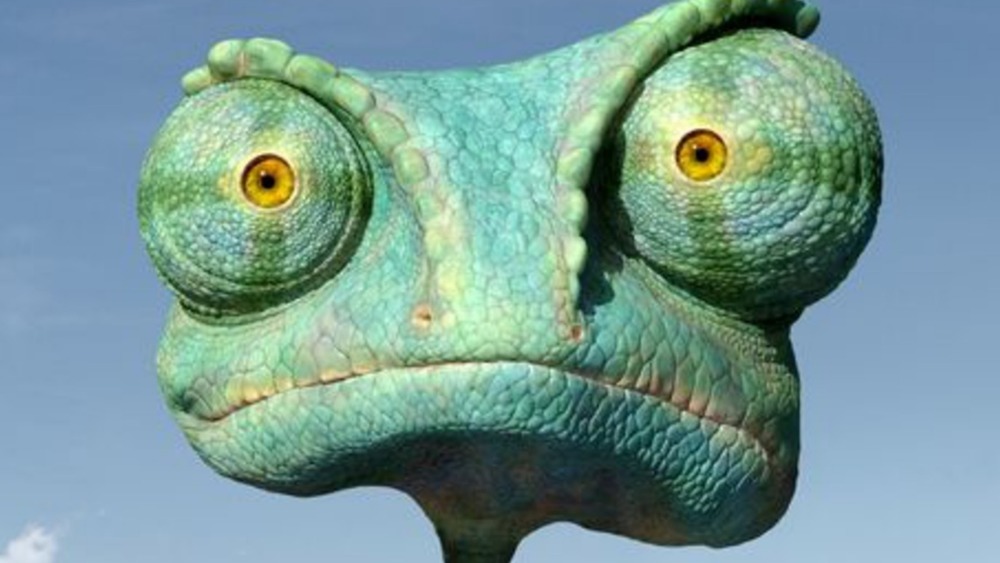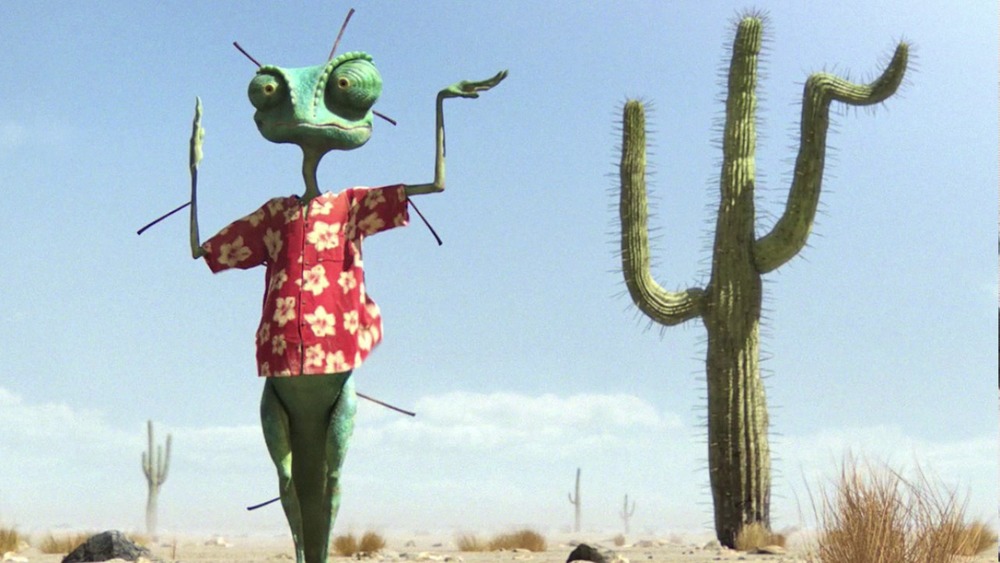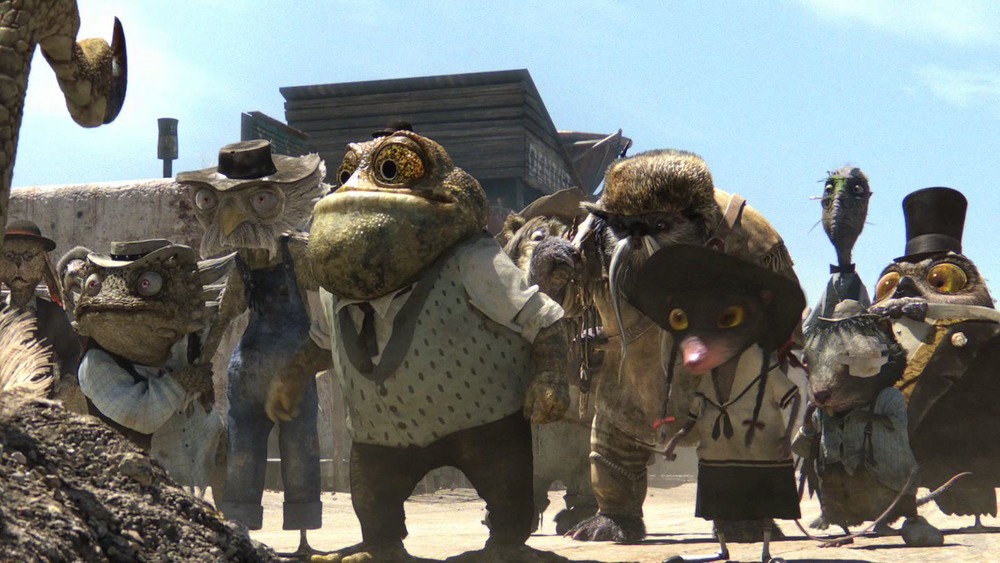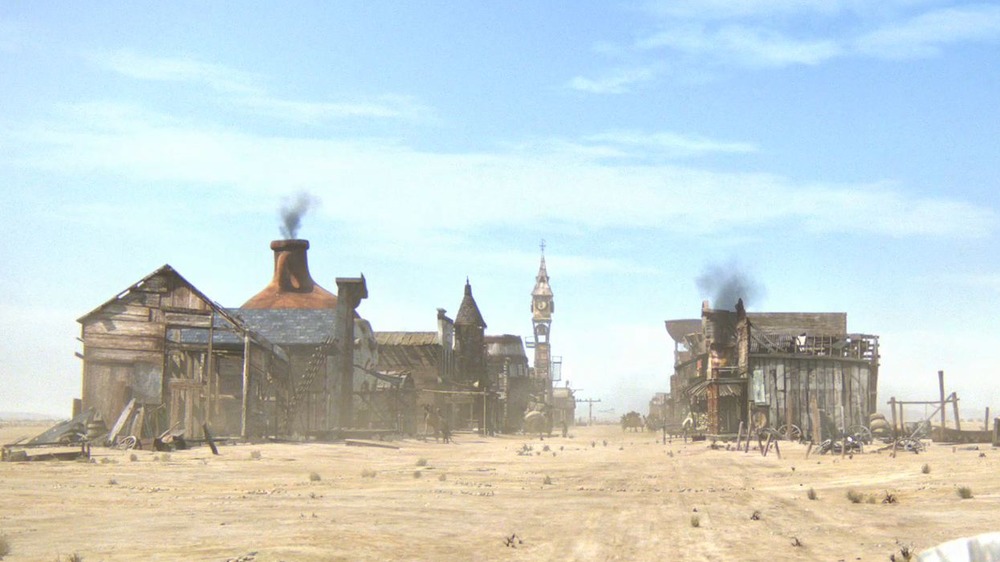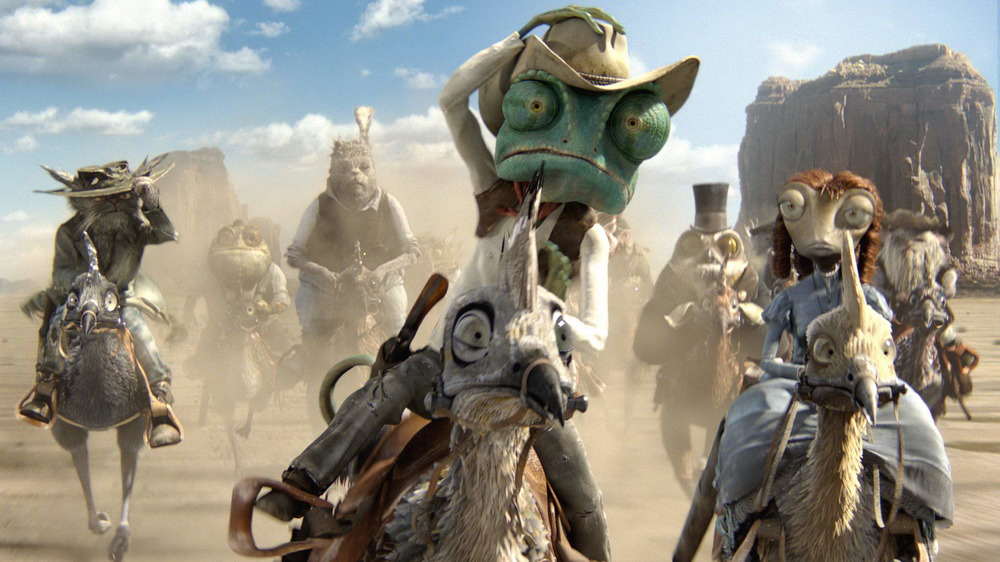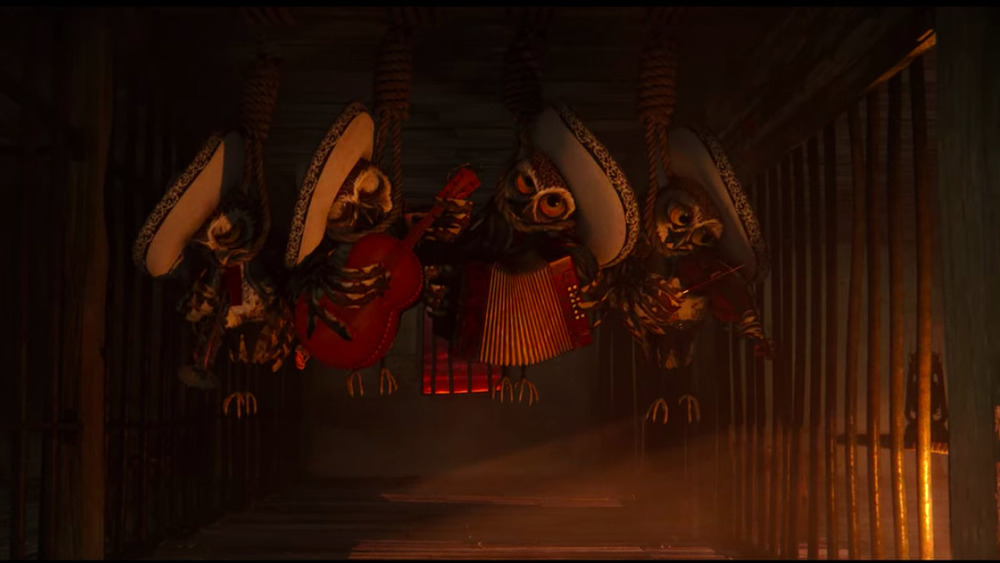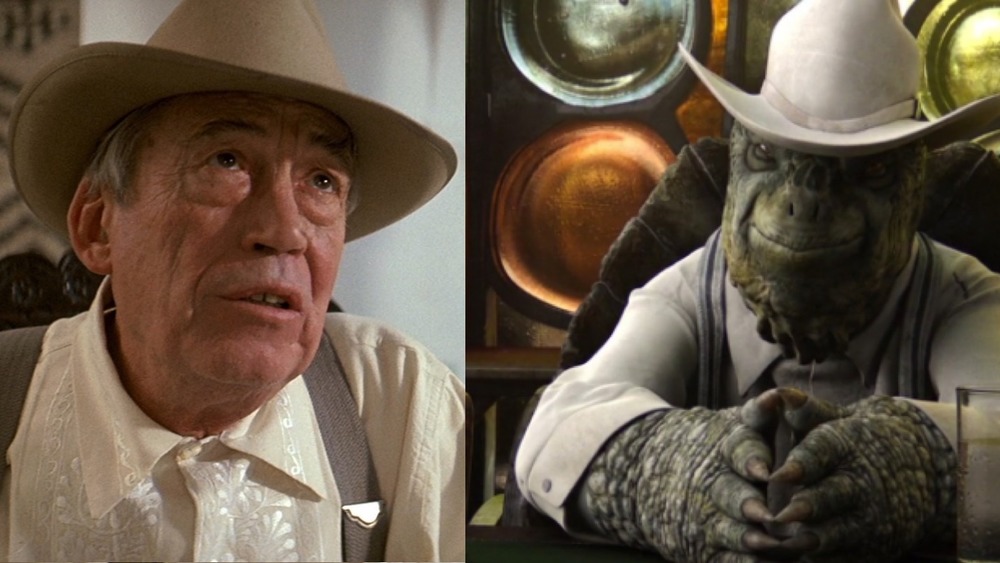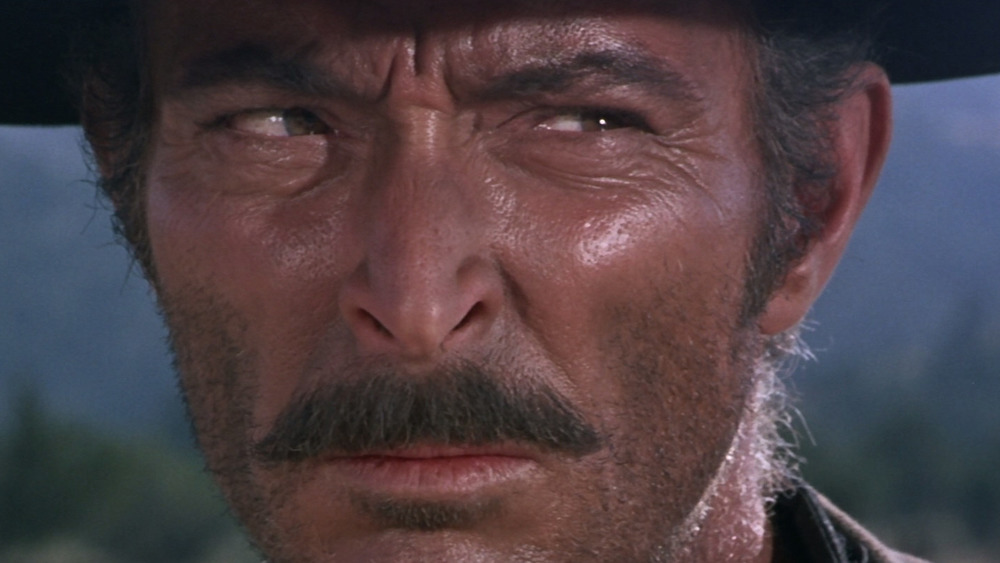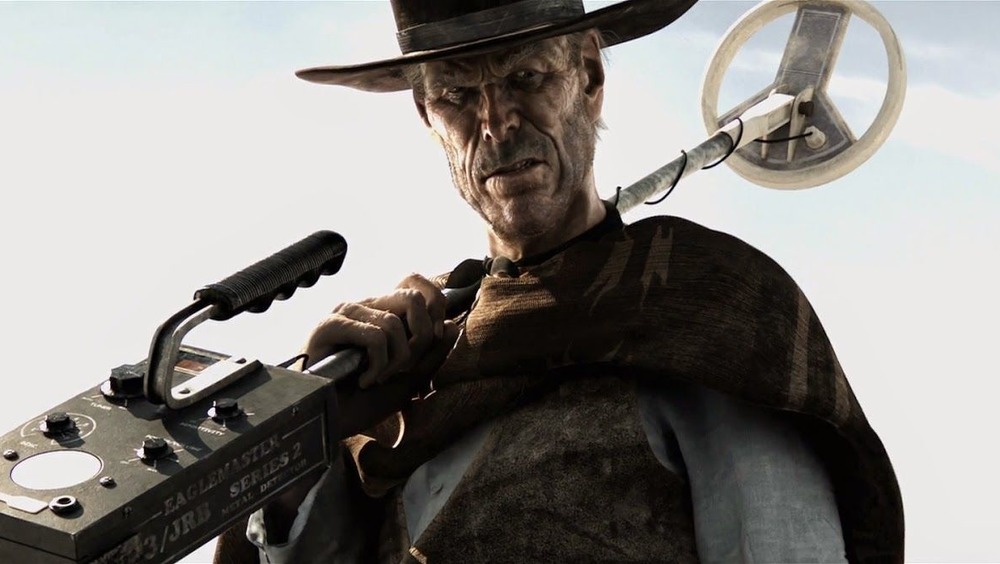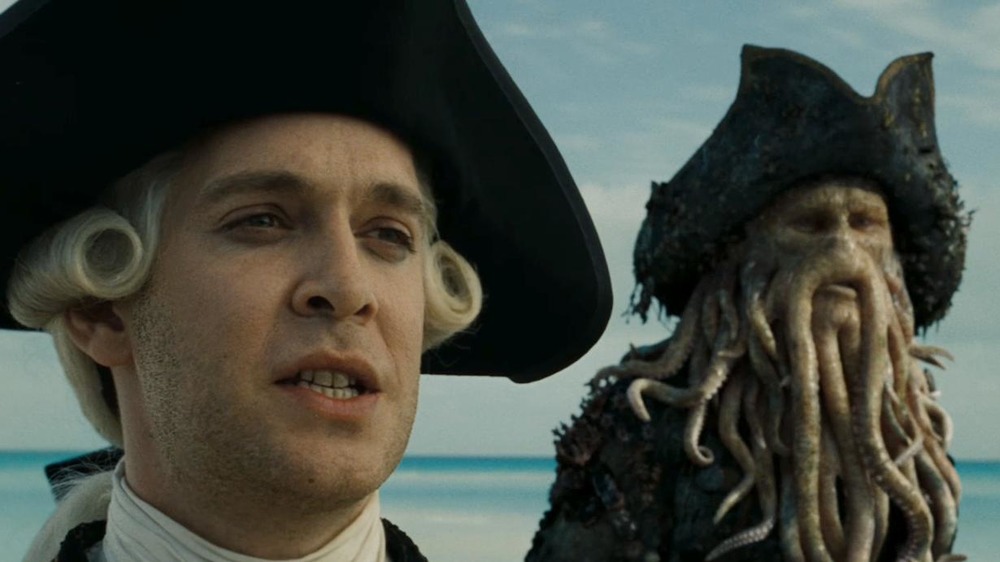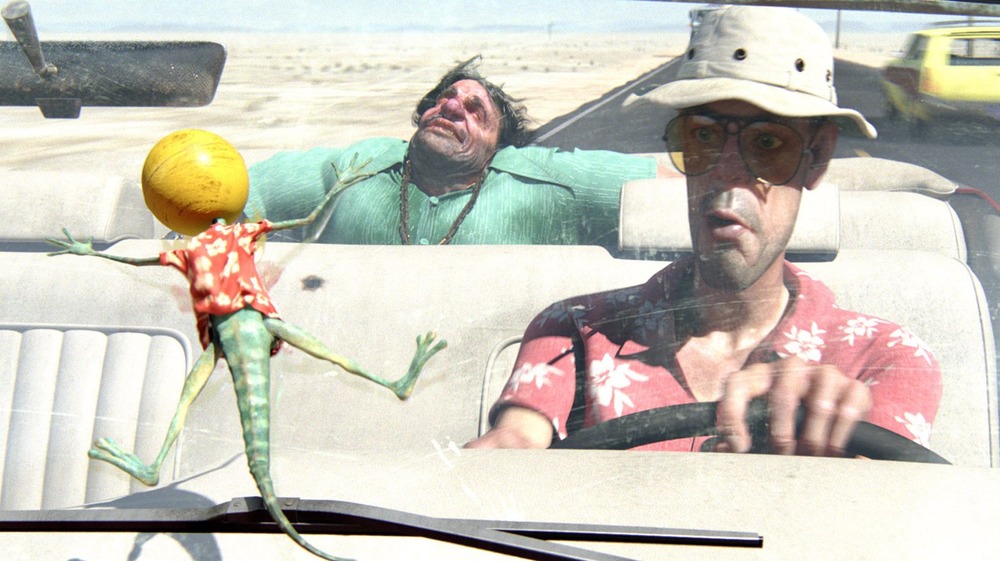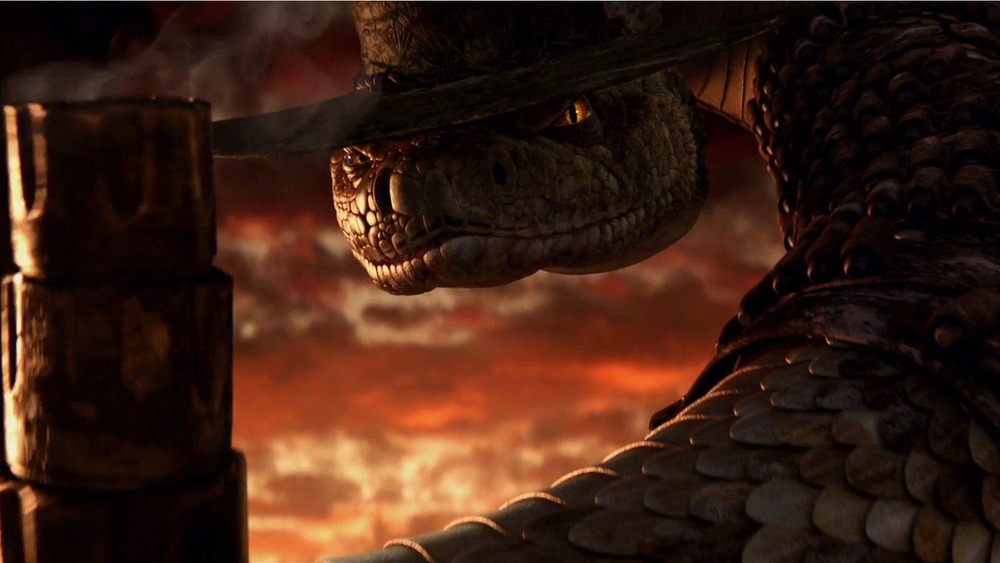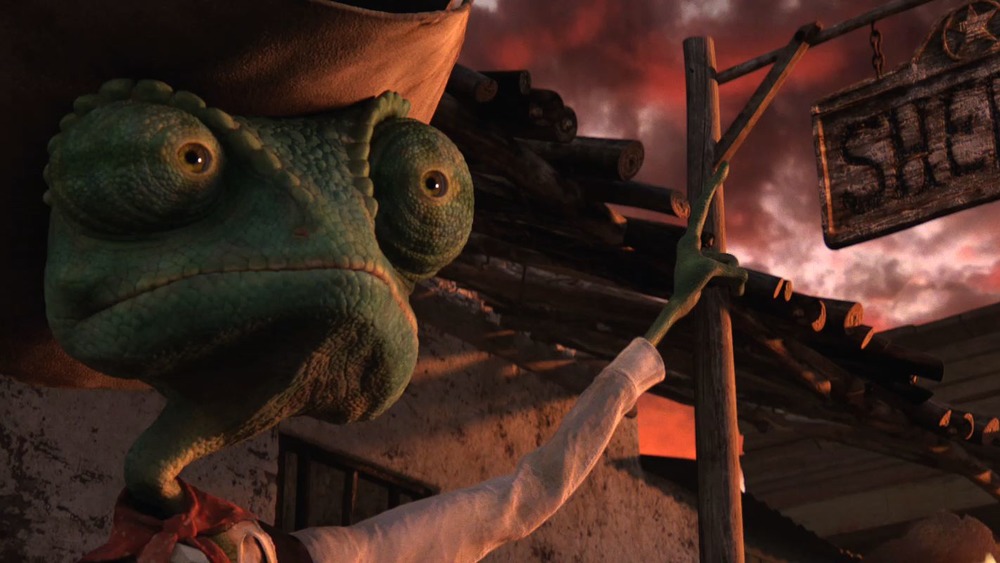Things Only Adults Notice In Rango
Not only is it a miracle that Rango is as good as it is, it's a miracle that it exists at all. Somehow, the legendarily risk-averse Hollywood studio system gave director Gore Verbinski the barrels of money necessary to make a kid-friendly animated movie that was also a meditation on American mythmaking and capitalist exploitation, one full of deeply surreal imagery and an even stranger sense of humor. Plus, in a medium built on cute characters who can be sold on every product imaginable, Rango's cast of desert critters are each deeply individual and frequently downright ugly.
But Rango does exist, and we're all lucky it does. For ten years now, it's entertained kids and adults with its story of a pet lizard (Johnny Depp) who falls out of the family car and wanders into the animal-sized down of Dirt, finding it on the verge of collapse thanks to a water shortage. Rango reinvents himself as a Western hero, and we watch to see if he can save the town before they learn he's a fraud. It's a movie as twisty and thorny as a saguaro cactus, and it flies in the face of all Hollywood's rules about what kind of entertainment is fit for the youngest audiences. As you might expect, that means a lot of it also flies right over the little one's heads, and if you haven't seen it since you were a kid, you'll find that there's plenty more to rediscover.
Rango's species is a subtle pun
Our unlikely hero's huge, lopsided eyes make him easy enough to identify as a chameleon. We even get to see him change color to hide from a predatory hawk, first by trying to "blend in" with the desert sand and then by striping himself red to hide in a pack of Twizzlers.
Additionally, Rango is able to slip into his role as a heroic gunslinger thanks to his profession as an actor. We first see him alone in his terrarium, trying to put on a play with assorted toys and a dead bug. These skills come in handy again later, when he's able to ambush the prairie dog family he thinks stole the town's water by distracting them with a performance of the same play.
It's an appropriate role for a chameleon, since "chameleon" has become a cliché description for versatile actors who can disappear into a wide variety of parts. And Rango's certainly able to blend in with the people of Dirt by convincing them he's a cowboy badass — at least, for a while.
There are loads of Easter eggs for animal buffs
A chameleon is an odd choice for an animated hero. Rango's certainly a long way from the limited cast of cats, dogs, and other fuzzy critters that dominate the cartoon landscape. But he looks downright mundane next to the rest of the cast.
Gore Verbinski teamed up for the movie with designer Mark "Crash" McCreery, who created the dinosaurs for Jurassic Park and, more relevantly, Davy Jones and his bizarre sea-creature cronies for Verbinski's Pirates of the Caribbean. McCreery brought the same tactility and individuality to the citizens of Dirt. They might seem to have come out of an especially drugged-up animator's imagination, but they're all more or less accurate representations of the real wildlife of the Mojave Desert. For example, the townspeople who join Rango's posse include a gap-toothed horned toad named Waffles, and the mariachi band that narrates Rango's adventure are burrowing owls. Since the animals are too small to raise cattle, they yoke their carts to wild pigs called peccaries.
But at least one member of the cast is even more out of place in the Mojave than Rango. He's greeted on his arrival in Dirt by Priscilla, a little girl who turns out to be at least as tough as any of the town's adults. She seems to be some kind of rat or possum, but the documentary Real Creatures of Dirt confirms that McCreery based the character on the aye-aye, a species of monkey from the African island of Madagascar. And yes, their eyes really are that big.
The critters built a town out of trash
The town of Dirt is just as fascinating as any of its citizens. Verbinski and his crew have created a fully realized universe, a believable community featuring animal-sized architecture. But if you look closely, you can see how some of it's been repurposed from the human world. The skyline of Dirt is full of familiar objects, most of them a little worse for wear, like an earthenware jug and a wooden barrel. Form follows functions for many of these buildings — the post office is a mailbox, the bank is an old travel trunk with a faucet handle above the door, and the outhouse where Rango hides from the hawk is a bottle of Pepto-Bismol.
You can see the animal's recycling ingenuity in the structures they've built up around these objects, too. They use matches and tractor blades to build balconies, and the Mayor's stained glass window is cobbled together from beer bottle bottoms. The bank vault is the tank from a water cooler, and the clock tower in the square is made out of pocket watches. This is all very subtle and clever, but the filmmakers aren't above some good old dad jokes, either. Check out the tower that supports those watches, and you'll see the animals of Dirt tell the time with some help from a bottle of thyme.
There's adult humor galore
Most family movies are examined with a fine-tooth comb for anything objectionable before they're pronounced fit for mass consumption. But everyone responsible for that must've been asleep when Rango came out. On top of all the salty language and alcohol, tobacco, and firearms, Rango is full of jokes that are hilariously inappropriate for little ears. To be fair to the forces of censorship, most of these jokes can take a while to parse, but as soon as you do, you'll be wondering how they ever made it to the screen.
When Rango claims he and the fearsome outlaw Rattlesnake Jake are brothers, he meets the reasonable objection that this should be impossible since he's a chameleon and Jake's, well, a rattlesnake. Rango explains that his mom "had a very active social life." Then, when Rango disguises his posse as a theater troupe, he announces them to the family of larcenous prairie dogs as "thespians." The hard-of-hearing patriarch asks for some clarification. "Thespians? But that's illegal in seven states!" And before the Supreme Court's decision to recognize gay marriage, that may well have been true.
Less explicitly sexual but still well over most kids' heads is Waffles' description of the mystery of Dirt's drought as, "A puzzle — like a great big mammogram!" And on a similarly medical note, Doc, the posse's rabbit physician, snaps on a latex glove to ask if anyone's ready for a checkup, implying he has something proctological in mind.
Spanish speakers will find some hidden messages in Rango
Some of Rango's adult jokes will be too much even for a lot of adults if they don't speak Spanish. The movie's border setting allows for a lot of bilingual humor, much of it provided by the mariachi owls, who trade off English and Spanish verses in one scene but change the meaning in translation: "La muerte allegado. Death has arrived. ¿Donde están tus huevos? How will our hero survive?" However, "huevos" actually has nothing to do with our hero's survival. Instead, it means "eggs," or in this context ... "balls." And that's not the movie's only testicular reference, with a toad threatening to "strangle" Rango's "huevos" when our hero exposes him to the hawk.
There's a similar in-joke when Rango meets his love interest, Beans. He's skeptical of her name, explaining, "I enjoy a hearty puttanesca myself, but I'm not sure a child would appreciate the moniker." Rango's line makes a lot more sense when you know, first, that putannesca is a type of pasta, but more importantly, "puta" is a nasty Spanish insult that means, well, we can't actually say on this site.
Rango is chock-full of Chinatown references
Even grown-ups might miss a lot of what's going on in Rango if they haven't gotten acquainted with the classics of film history. Naturally, there are dozens of callbacks to the best of the Western genre, but there's no movie Rango owes more to than Chinatown.
This 1974 classic fictionalizes the land grab that built Los Angeles as a detective story. Here, Jack Nicholson plays private eye Jake Gittes, who discovers a conspiracy to cut off poor farmers' water to force them off their land, buy it up cheap, and turn a profit by restoring the water supply.
The villainous ringleader in Chinatown is John Huston as Noah Cross, who bears a striking resemblance to Rango's Mayor. The devious tortoise doesn't just have the same plan, he's a dead ringer for Cross, with his cowboy hat, suspenders, and jowly facial features. And Ned Beatty (who played another ingratiatingly corrupt cartoon villain as Toy Story 3's Lots-o'-Huggin' Bear the previous year) does an eerily good impression of Huston's Midwestern drawl and ability to turn on a dime from avuncular charm to menacing growl.
There are other similarities, too. Both characters monologue to the hero about their plans to own "the future," and both drown potential snitches before dumping their bodies elsewhere. And both Rango and Jake Gittes get suspicious when they see gallons of water being dumped through a huge culvert pipe.
The Good, the Bad and the Ugly was a major inspiration
The Westerns of old loom large over Rango, especially one that was made on the other side of the Atlantic. The Good, the Bad and the Ugly is Italian director Sergio Leone's third film starring Clint Eastwood as the Man with No Name (the Good), this time pitting him against Lee Van Cleef as Angel Eyes (the Bad) and Eli Wallach as Tuco (the Ugly) in a race to a chest full of Confederate gold. Rattlesnake Jake owes more than a little to Van Cleef, wearing his trademark black, flat-topped hat. Verbinski even gives the hairless reptile Van Cleef's distinctive mustache by burning it into the black scales above his upper lip.
One of The Good, the Bad and the Ugly's most memorable scenes is the ending, where, as the Man with No Name leaves Tuco behind in a graveyard, Tuco screams, "You know what you are? Just a dirty son of a —" before getting cut off by the wordless vocalization of Ennio Morricone's iconic score. Rango gets in a fun parody of this classic moment when the hawk flies off with a toad who shouts, "You son of a —" but like Tuco, he's drowned out, this time by the hawk's high-pitched cry.
The Spirit of the West takes the form of a Hollywood icon
Rango is haunted by legends of the Spirit of the West, a mystical entity who "rides in an alabaster carriage with golden guardians." The whole plot gets set in motion when Rango's owners swerve to avoid a Don Quixote-esque armadillo who's questing to meet the Spirit. And at Rango's darkest moment, after Jake has exposed him as a fraud, he undergoes his own quest in the film's most beautiful moment, finally reaching the other side of the road and meeting the Spirit.
Film buffs should recognize the Spirit as Clint Eastwood, dressed in costume as the Man with No Name. The Spirit gives Rango some deadly serious enlightenment, but that doesn't stop Verbinksi and crew from having a little fun with the gap between the mythic Man with No Name and the reality of crotchety, old Eastwood. We're introduced to the Spirit as he putters around with a metal detector. The "golden guardians" are awards statues, which he keeps in the basket of his "alabaster carriage," which turns out to just be a golf cart.
Eastwood himself apparently couldn't make it, but we get the next best thing, with Timothy Olyphant providing the Spirit's voice after portraying his fair share of modern Western icons on TV in Justified and Deadwood.
There are plenty of Pirates parallels
You may wonder why a major studio would hand Gore Verbinski the tens of millions of dollars it took to realize this weird, weird film. But in 2011, Verbinski could do no wrong, coming off the overwhelming success of the Pirates of the Caribbean trilogy.
Johnny Depp worked with him as both Rango and Captain Jack Sparrow, but the similarities don't end there. In fact, Rango shows Verbinski exploring the same themes that drove the Pirates movies and would continue inspiring his next film, The Lone Ranger. For example, there's the effects of Western civilization's advancement into new territory, erasing the old world of heroes and legends. These movies all pit their heroes against dual forces of evil, one representing the respectable world of politics and commerce and the other a more unrestrained, mythic kind of evil.
In Rango, the Mayor steps into the role played in the Pirates movies by Lord Cutler Beckett of the East India Company. Meanwhile, Bill Nighy, who played the supernatural pirate Davy Jones, returns here as Rattlesnake Jake. But Verbinski isn't just repeating himself here. Beckett controls and defangs Jones by stealing his disembodied heart. The Mayor tries to do the same with Jake and even plans to kill him, believing he comes from the same outmoded, legendary world as Rango and poses just as much of a threat to his power. That doesn't work out, and we last see the Mayor in Jake's coils, being dragged over to the horizon where some horrible fate awaits him.
Johnny Depp meets Johnny Depp
Rango makes time for a brief crossover with one of Johnny Depp's earlier films. In 1998, the actor starred in an adaptation of his friend Hunter S. Thompson's semi-autobiographical novel Fear and Loathing in Las Vegas as Thompson's alter ego, Raoul Duke. Like Thompson, Duke is a journalist and heavy, heavy drug user who books a hotel in Las Vegas to cover a motorcycle race, but things quickly descends into a strung-out nightmare.
After falling out of the family car, Rango is swept up in the wind kicked up by a passing truck and ends up flying all over the highway, eventually slamming straight into the window of a car with a familiar-looking occupant wearing Duke's signature Hawaiian shirt, tinted glasses, bucket hat, and cigarette holder. Raoul (once again played by Depp) gets one line — "I knew it!" The implication is the scaly Rango reminds Raoul of his hallucination where he "was right in the middle of a f***ing reptile zoo, and somebody was giving booze to these g**d***things."
Fear and Loathing in Las Vegas wouldn't be a bad alternate title for Rango, either. He discovers the Mayor's plan when he finds the pipe that diverts water to Vegas, and the Mayor uses the same network to drain water from Dirt to his own animal-sized resort.
Verbinski uses the frame to make Rattlesnake Jake extra terrifying
There's a lot to love in Rango, but there's little in the film that's quite as effective as Rattlesnake Jake. He's a monstrous gunslinger who's replaced his rattle with a revolver, and he turns the movie from a lighthearted comedy into a horror movie when he appears. He claims to have come from Hell itself, and listening to Bill Nighy's abyssal growl and looking in Jake's flame-colored eyes, it's easy to believe him.
Kids will recognize the terror they feel when Jake is on the screen, but it takes a little more knowledge of filmmaking technique to realize just why he's so scary. One reason is the way Jake throws off our sense of scale. He's a literally monstrous presence. His head alone is almost as big as most characters' entire bodies, and Verbinski frames Jake in such a way that we feel just as small as the little lizards in his presence. We never quite get to see all of him at once, as if the frame can't contain him in the same way that reality can't contain his mythical, possibly supernatural existence. He doesn't seem to be more than three or four feet long, but the filmmaking forces us into the perspective of Rango and makes him seem enormous. And the way Jake crowds the frame preys on the audience's claustrophobia to make him even scarier.
Rango has an adult-sized vocabulary
One of the biggest reasons for the success of Depp and Verbinski's collaboration on Pirates of the Caribbean was Jack Sparrow's rapid-fire wordplay and flowery dialogue. And despite the absence of Pirates screenwriters Ted Elliott and Terry Rossio, that's even more true of Rango. It's hard to imagine any kids keeping up with everything coming out of these characters' mouths when they deliver dialogue like, "Get your slimy, webbed phalanges off ma boots!" or, "The lonely constable on his rounds, keeping an eagle eye out for mayhem and malfeasance."
And erudition often comes from the strangest places, like when the angry hayseeds of Dirt will suddenly drop phrases like, "Dysfunctional family — need intervention," or, "We are experiencing a paradigm shift!" into their arguments. Even Bad Bill, the thuggish gila monster voiced by Ray Winstone, can get downright poetic when he threatens Rango that, "If I ever see your face again, I'm going to slice it off and use it to wipe my unmentionables." And that's just a brief sample of the dictionary-busting dialogue you'll find if you give Rango another look. As long as you keep your eyes and ears open watching it, you'll never run out of new layers to explore.
